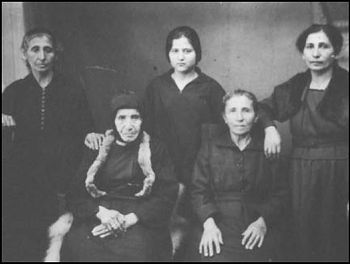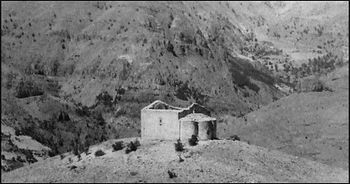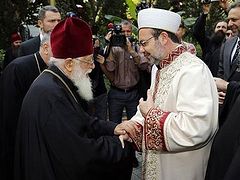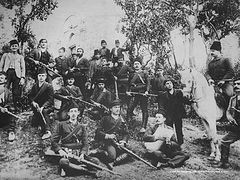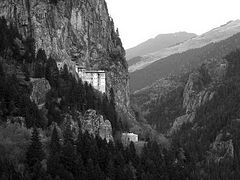…Krom, he who has been born in your mountains, grown old on your
peaks, and been buried in your earth, for what does he need paradise?
(Kromnean folksong)
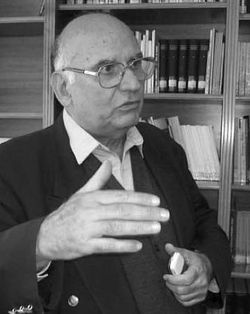 George Andreadis
George Andreadis
The Beginning
My grandmother Aphrodite never said an untrue word. When we pressed her for details or explanations, instead of adding something to make the story more interesting or giving possible reasons, she would only answer, "I don’t know. That was how it was when I was born." She could neither read nor write, nor did she understand chronological dating. She dated as the ancient Greeks, who referred to the events of a reigning king, the number of the Olympiad, or a great catastrophe. For instance, when my father would say that a certain woman was born in 1914, my grandmother would reply, "I don’t understand what that means, but she is 40 years old." My father would argue, "But if she is 40 years old, that means she was born in 1914." "I don’t know about that, but she was born the second year after the Turkish invasion of Batum, during the typhus epidemic." Where did my grandmother learn this ancient Greek system of dating? It was tradition. "It was what we have always done."
And this is how we arrived at the year of the death of my grandmother’s great-great grandfather. We knew that he died at 83 years old, and that his daughter, my grandmother’s great-grandmother, was 59 that year. Going back, we calculated that he had died in 1843, which fit precisely with the names of the local rulers and the events that my grandmother described.
When my father and I, as well as professional historians, have worked backwards to verify the dates of the events she narrated, Aphrodite was always right. I say this to pass on my faith in the historical accuracy of everything that she told me. In the following account, although calendar dates and general historical and political events are my own research, the details of Kromnean crypto-Christian life and customs are from my grandmother and from Fr. Nicholas Economides of the Church of Metamorphosi (Transfiguration) of Kalamaria, Thessalonica, who was also of Pontian descent, and who told me much about the crypto-Christians. My grandmother did not have this larger historical view. She knew nothing about the oppression that had caused the Christians to conceal themselves. She would only reply, "We were born into this. We were thus, and we lived so…"
My family was from Pontus, a region on the Black Sea coast that had Christian inhabitants even before Emperor Constantine the Great legalized Christianity in 313. After Constantine, the Christians lived in peace for almost 200 years until the early sixth century, when Byzantine Emperors Justin I and Justinian I came into conflict with the kings of Persia, Kavad I and Khosro (Chosroes) I. There were fierce battles in the area of Trebizond (modern-day Trabzon) and many of the local people took refuge in the mountainous area of Kromni, building their homes on the tall forested cliffs (in Greek, Kremos), away from the Persian raids. These people were called Kromet, or Kremet, or more recently, Kromnaioi [Kromneans]. During the seventh-century reign of Emperor Heraclius (610-641), the Byzantine Empire was divided into administrative units called themes and Pontus fell into the 21st theme, the prefecture of Chaldia.
Under the Byzantine Empire of the Comnenes, the Kromneans heavily fortified the area. Although rugged and isolated, Kromni was in the pathway of Mongol raiders who frequently attacked Trebizond. Later, Armenians invaded the territory, killing off whole generations until only a small remnant survived.
For centuries, Pontus was isolated by its 700-mile chain of towering peaks and river-fed chasms, threaded with narrow muddy tracks on which, even now, it is easy to lose one’s way in the dense forests of black pine and impenetrable alpine mist. As if approaching an island, visitors sailed to Pontus over the Black Sea rather than attempt the unyielding peaks from the south. Beyond the torturous summit of the Zagara pass, and several days journey by pack animals from Trebizond, the barren low-lying mining region of Kromni was an isolated refuge for crypto-Christians. Eagles and vultures, wild boar, deer, bears and wolves, all made their homes there.
The area, of course, was completely Christian, and being on the coast, Trebizond was always the largest city of the area and the episcopal seat. In 1461, eight years after the Fall of Constantinople, when the Sultan Mehmet Fathih (Mehmet the Conqueror) conquered the city, it had 25,000 Greek Christians and over seventy churches. At the conquest, 800 young Pontian Christians voluntarily went over to Islam. Through inheritances and bequests, the Pontian Church had become a huge land-owner, and it was said that some monasteries took advantage of their tenant-farmers. For some of these young people the coming of Mehmet could have seemed like a socialist movement, and they may have thought, "Now is the chance for us to get ahead."
After the conquest, Sultan Mehmet II left his Christian subjects the right to hold religious services, perform marriages, adjudicate court cases between Christians, and educate Christian youth, overseen by the patriarch of Constantinople. But there were also many evils: churches were seized and turned into mosques and, for over 200 years, the Turks took the strongest and brightest boys from Christian families in Ottoman-occupied Europe and forcibly converted them to Islam as Janissaries – an elite military corps dedicated to the sultan.[1] Still, Christians played an important role in maintaining standards of law, medicine, and academics. Often more educated thantheir Muslim conquerors, they were necessary to the administration of theOttoman Empire.
In the 16th century, however, Muslim fanaticism arose. Constantinople (today’s Istanbul[2]) was no longer so closely watched by the European Christian countries which were fighting their own wars, and the Turks divided the country into regions, each under a terebey – a landlord. Each terebey was a despot. If the terebey was good, his subjects lived in relative peace; if not, they suffered. But whether the terebey was good or bad, each one was chosen as a devout, even fanatic Muslim. The religious toleration of Sultan Mehmet II was forgotten, and oppressive taxation and violence against Christians increased. The main square of Trabzon is still called Gavur Meydani (The Square of the Infidels). Why? Because it was during this difficult time in the 16th-17th centuries that the farmers around Maçka attempted a revolt. Knowing that Friday was the Muslim day of prayer, they came to the city armed with scythes, axes, and other field tools, to take the city. The revolt failed and five thousand Christians were killed in this square.
Although some Greeks remained openly Christian, burdensome taxes and discrimination caused many to convert to Islam and their children today are Turkish Muslims. Another large group said, "No, we will keep our religion, but how will we survive? How can we save our lives and the honor of our daughters?" In the end, they became secret Christians.
Although denying Christ, even outwardly, is a sin for a Christian, during these times when many civic leaders, the educated, and wealthy turned to Islam, how could illiterate and primitive mountain people be held accountable? In many cases the Eastern Christian Church accepted the solution of crypto-Christianity so as to withstand the waves of voluntary and compulsory Islamization that were leaving churches empty of believers.
These Greeks of Asia Minor lived as concealed Christians for almost 200 years. Although this has been called a mercenary response to avoid harassment and excessive taxes, harsh periods of oppression could have meant economic ruin and starvation. Without knowing the individual circumstances, it is impossible to judge the motives of those who chose this way of life. Maintaining a secret Christian life was always difficult and dangerous. By strict Islamic law, faithful Muslims tolerate Christians and Jews, but the conversion of a Muslim to another religion is punishable by death. Thus, the choice to become crypto- Christian affected not only those who made the initial decision, but their descendants for many generations, who, even if they desired, could not reveal their faith. In public they were Ottoman Muslims.
Not only were they obliged to appear Muslim, but crypto-Christians were often isolated from fellow-Christians who openly professed their Christianity, and in some areas it would have been a great mistake to tell other Christians of their existence. If a private dispute later arose between them or their families, the professed Christians could simply go to the Ottoman authorities and give them away.
In Kromni, however, relations were good, and the professed Christians, who began moving into the area in the 1700s to work in the mines, lived in peace with the crypto-Christians. The crypto-Christians, who had secreted themselves fifty years before, knew, of course, who the professed Christians were and as "Muslims" quietly helped them when any problem arose with the Ottoman authorities. The professed Christians who knew about their neighbors never betrayed them. The fear of God possessed them all. Often, the only person who had extensive knowledge of which villages and families were crypto-Christian was a local hierarch, such as the metropolitan of Trebizond, who ordained priests for them from among their own people. In each case, the professed Christian bishop of the area was aware of their hidden existence, as the sacraments could not be served without his blessing, and in Pontus there were no crypto-Christian bishops.
As I said, throughout these two hundred years, the crypto-Christians of Kromni protected the openly professed Christians. For example, at the beginning of the 19th century, when the Greeks of the Peloponnese rose up against Ottoman rule and destroyed Muslim villages, a group of fanatic Muslim young people took to the streets of Trebizond to "kill the infidels," rounding up and imprisoning all of the professed Greek Christian men. They were rescued by Osman Bey, the governor of the Trabzon region, who was himself of crypto-Christian origin. Real Ottomans rarely lived in the Kromni mining villages, so their administration almost always fell to the lot of Muslims who were crypto-Christian. Many of these crypto-Christian aghas and elders were coarse and wicked, yet both the crypto-Christians and the professed Christians preferred them because they knew that their lives and their honour were safe.
The crypto-Christians had no written contracts between themselves. Any business agreements, purchases, rentals, or marriage settlements began with the set phrase: "In the name of the Holy Trinity and the 318 God-Bearing Fathers…"[3] Such an agreement was never known to have been disputed, nor did anyone ever threaten to inform the authorities. These agreements were kept because people pledged on their faith in Christ and the Virgin Mary; it was impossible to break such a contract. Now, they break even written ones.
Kromni Under the Ottomans
Kromni began to prosper around the time of Sultan Murad IV (1623-1640), after the sultans decided to mine the mineral wealth of the area. The mines quickly multiplied and so did the workers, who at first were mostly crypto- Christians seeking places away from the large coastal towns and Ottoman administrators, where they could more easily maintain their manners, customs, language, and religion. As the mines were the property of the Sultan and those who worked them were classified as public servants, miners and their families were exempt from serving in the Ottoman army, which was otherwise compulsory for all Muslims (and crypto-Christians who appeared to be Muslim).
The general supervisor, who advised the Sultan, and the mines’ chief managers, could only be Muslim Turks, but many crypto-Christians who were believed to be Muslims reached these positions. Because the Turks looked down on this work, the miners were almost exclusively Greek, and this was the goal of the crypto-Christian administrators, who wanted to maintain an ethnic homogeneity without spies or traitors. At the time of its greatest prosperity, the area was inhabited by 6,000–10,000 people in the area of Kromni, and 60,000 in nearby Argyroupoli, all of whom spoke a Greek dialect called Roméika, as do many of the Black Sea Turks today.[4] The Turks had no interest in whether the miners spoke Greek or Turkish, as long as the mines were properly run and taxes were paid. Over time, the isolated Kromneans became relatively secure and, once the Hatti Humayun decree of 1856 granted a margin of tolerance, they were quick to establish Greek-speaking schools.
Kromni was comprised of the following districts: Alithinos, Frangandon, Glouvena, Kodonandon, Loria, Mohora, Mantzandon, Nanak, Rakan, Roustandon, Sarandon, Samanandon, Sainandon, Tsahmanandon, Zeberekia, and several smaller villages. In the 1700s, despite a small openlyprofessed Christian population and the secure life and stable income of the mines, there were no churches in Kromni. The ruins of a monastery that had been destroyed at the time of the Persian invaders still stood on Mount St. Zacharias, and the remains of an ancient church could be seen in the center of Kromni, but under Turkish law, neither new churches could be built nor old ones repaired. Strange to outward eyes, however, neither did this entire region of "Muslims" have a single mosque, as if they were infidels.
Yet there was no place that had as many secret churches as Kromni. Every house had a tiny catacomb chapel in which the crypto-Christians secretly fulfilled their Christian duties, concealed from visiting Muslims and the few Ottomans who lived with them as public servants and administrators. There were also other places of worship. For instance, near the village of Sarandon was a bush-covered hill with a secret entrance leading to a cavechurch, Krymentsa Panayia which they called "The Hidden Virgin." The church persevered there, undiscovered for centuries, inside the little hill. The crypto-Christian house churches were normally underground and one entered through a trap-door, from which steps led down into the chapel. The trap-doors were hidden from view under fodder, or behind furniture or provisions. After dark, with curtains drawn and shutters closed, the floor covering or furniture could be pulled back, and people would descend to pray. The iconcovered walls were lit by small oil lamps and beeswax candles, heavy with the scent of resin incense. It was here, in their own tiny catacomb churches, that Christians gathered at night for services, prayers, and sacraments.
The Pontian houses, called saray, were decorated outside with simple blue geometrical designs or flowers. The crypto-Christian houses were no different from the seraya of real Ottomans. They generally had two floors, the ground floor being the stable, on one side of which the animals were kept, while the other was generally used for storage. Inside this storeroom was the trap-door with steps leading to the secret chapel. In those days, the dress of both men and women was noble, the clothing of the Ottoman Orient. Men wore long, loose breeches that flowed out on either side as they walked. A belt at the waist tied the long shirt to the breeches, and a vest added dignity. During the winter, the men wore magnificent overcoats and their heads were covered with fez or turbans. Women’s clothing varied from region to region, some rather European, others more eastern, and as one can see from old pictures, it was both beautiful and graceful. Even at the end of the 19th century, when the Kromneans were able to publicly proclaim their Christianity and many of the men threw off their Ottoman dress for the Greek Pontian zipkes (trousers), others continued to wear their Ottoman clothes, seeing in them a mark of dignity.
Mullah Molasleyman
This was the time in which my grandmother’s great-great-grandfather lived. He was born in Ottoman Varenou on February 2, 1760, left Varenou when he was sixteen and returned six years later, when he married and had a family. Of those six years, my grandmother Aphrodite only knew that he went first to Trebizond and then to Constantinople. When he returned to Varenou, however, he could read and write Turkish and Arabic, and could recite Arabic texts from the Koran with an ease unknown to the peasants in those years of ignorance and illiteracy. In a short time he became the hodja for the Muslims of Varenou and the villages around Kromni. Although young, he was serious and clever, and after a few years was the only person trusted to advise and adjudicate between the peasants of his area. He was known as Mullah Molasleyman, and everyone respected him as a cleric and as a kadi (a judge)[5] He was their native son, their own hodja. His knowledge of Turkish was a great help to the villages, as he could communicate with the Turkish-speaking public officials sent to Kromni by the Ottoman rulers of Argyroupoli (today’s Gümüshane), the district to which the villages of Kromni belong. Even in the 1700s, the Muslims of Kromni did not speak Turkish, but the so-called Greek Roméika, and the few Turkish families who settled there afterwards forgot their Turkish within two or three generations. My grandmother was unable to explain how such things had happened, but answered negatively when I asked her if these Muslims were Greeks (Romioi) who had become Muslim by force. Although she was letter-perfect in our family his tory, this simple woman had no way of knowing the historical events of the six generations from "the change" around 1650, when the Pontic crypto- Christians first appeared, until they were able to declare themselves 200 years later. Even now, in the areas of Ofi (Of) and Thoania (Tonya), the Muslims speak Roméika as their mother tongue, and they call the period of Ramadan Triod (i.e. Triódion, the Greek for the three-ode canons sung during Great Lent).
An absolute majority of Kromeans were crypto-Christian. Among them were local people of distant Persian descent who had also become Christian, and a few foreign technical specialists for the mines. We know of these foreigners because of the area called Frangandon (Europeans were called "Frangos" in the local language, and surnamed after their nationality, such as "Germanides.") Mullah Molasleyman was ordained an Orthodox priest by Dorotheos III, Archbishop of Trebizond (1764-1790), after his return to Varenou in 1782.[6] Although the area of Kromni belonged to the Metropolis of Chaldia, the crypto-Christians of Kromni were under the Metropolis of Trebizond for security. The Chaldian diocesan headquarters in Argyroupoli was too small and close for frequent contact to go unnoticed, but Trebizond was a large city, 120 kilometers away. It was not uncommon for an Orthodox crypto-Christian priest to also act as the local mullah in crypto-Christian communities. He was often the only educated person who could speak and read Turkish, Arabic, and ecclesiastical Greek (enough for the services), as well as Roméika. If the village was all crypto-Christian and very isolated, the crypto-Christian priest did not have to pretend to be a Muslim mullah, he was simply known to the outside world as a simple Muslim. But if the village was larger or had enough of a Muslim population to have a Turkish gendarme, the priest was also often the mullah, which added to the security of the crypto-Christians. If a crypto-Christian acted as mullah, he was also the defacto leader of the Muslim community, and would know immediately if there was a threat against the Christians. This had to be, because what explanation could a village give for not having Muslim religious services? Even if they had no real Muslims in the village, they had to have someone official to show when the authorities came around, because outwardly they were Muslim. If there was no local mullah, who was also one of them, it would have been a terrible problem. In Mullah Molasleyman’s village of Varenou, surprisingly, there was no mosque or even a simple camii, the open-air platform set aside for Muslim prayers in villages that could not afford to build a mosque. The villagers of Varenou always told visiting Turkish officials, "We are too poor to build a mosque, but we will try to gather the money to build a camii." The camii was never built.
Festal Customs: Theophany Eve and the Church New Year
My grandmother used to say, "As secret Christians, we were more strict than the open Christians. We kept every feast and every tradition." The feasts were celebrated with absolute secrecy, the fasts kept with great solemnity, and liturgy and Holy Communion took place with the fear of God. Great church feasts were celebrated much as they are now, but I will mention some customs that have disappeared in our times. A deeply moving tradition took place on the eve of Theophany. The family gathered in the underground chapel where, on a small table, they placed a bowl of wheat and corn into which they put lit candles, each candle dedicated to a dearly deceased member of the family. The last candle was lit for the unknown dead, for those who had no one to commemorate them. The small dark church was lit only by these candles, and the family remained there, with the priest or head of the family offering the prescribed prayers and chants until the last candle melted.
Each year on the 1st of September, the Church New Year, from before dawn the priest visited the homes of all of the crypto-Christians, sprinkling each house and its residents with holy water. This was a very old custom, older than Christianity itself, as the ancient Greeks also considered September 1st the first day of the new year. Another very moving custom was the quiet walk of a secret priest through the village streets to the house of a dying Christian. Under his clothes, he held the chalice with Holy Communion. If someone saw the priest and greeted him, he would not answer, but continued on his way in silence. No one misunderstood. The priest’s silence always meant that he was visiting the dying.
Crypto-Christian Baptisms
For baptisms, family members, godparents, and perhaps a few others gathered at the child’s house. Babies were usually baptized after forty days, unless a close member of the family had recently died, then the baptism was held only after the first year memorial service for the departed. The child was then given his Christian name, although he also had a "Muslim" name to use in public. Children of crypto-Christians who were not old enough to keep the community’s secret were not present at any of the sacraments; only when they grew old enough to be trusted, could they attend and be catechized. As was traditional throughout Greece and Asia Minor, the mother of the child was never present at the baptism (signifying that the child belonged to God), but waited in another room or even in another house. The godfather rarely knew the whole creed, but only said, "I believe in One God, Jesus Christ…," yet he meant it deeply. When the baptism finished, a child ran to where the mother was staying, congratulated her and announced the child’s baptismal name, which had been given by the godfather or godmother. There was often a race among the village children to reach the mother first, as the one who did so received a present which the mother had especially prepared for his coming.
Even during my childhood here in Greece, most of the baptisms were done at home because of the lack of heat. The mother waited in her room, and as soon as the name was pronounced, all of us young ones went running to be the first to tell.
Kromnean Betrothals and Marriages
In those years, Christians and Muslims all married early, the girls as young as twelve to fourteen. By sixteen, they were in danger of spinsterhood, and after twenty, there would be no more offers. The boys also married young, although most were older than their brides. All weddings took place between January until Great Lent, and after Dormition until the Christmas Fast. As is usual in Orthodoxy, there were no weddings during the four great fasts, nor, by local tradition, in May or in leap years. Kromnean folk custom considered leap years to be ill-omened, a break in the normal cycle, and May was the month in which donkeys were bred; Christians waited for a more suitable time to celebrate the sacrament with dignity. There were several steps to arranging a marriage in Kromni. The first was the Aaeman, the "Finding," when a young man’s parents looked for the right girl, or rather, for the right family from which they wished to take a bride. Once the prospective bride was found, the family sent the local matchmakers, who were expert in these affairs, to the family of the girl with a Psalapheman (the Proposal or Request). If the girl’s parents were in favor of the match, then negotiations for the dowry would proceed. If they were unfavorably disposed to the proposal, the boy’s parents would almost always abandon their suit immediately to save face. If there was a very strong reason to acquire this particular girl as a bride, she could be abducted (the Syrsimo), and then the marriage would have to take place, but this was rare. The dowry was usually money, land, or household gifts given to the groom’s family by the family of the bride, as the bride would go to live with her husband’s parents. (The Turks did the opposite, where the dowry was "paid" by the groom’s family to the bride’s father, depending on her social status and accomplishments.)
There were rare cases when a young man fell in love with a girl whom he managed to see with her face uncovered, usually at the spring where the girls drew water. Seeing her unveiled demanded a proposal. Because of the strict social traditions, if the young man’s parents were against the match, the following happened: respected older village women took the girl to visit the groom’s house. After some time they left, leaving the girl there, and said, I níphe ekatsen ka ("The bride has sat there"). This was an extreme attempt to change the mind of the groom’s parents, and there was not a single case of parents-in-law sending away a bride who had "sat" in their house. It would have been considered a great sin, completely socially unacceptable, and might even have been dangerous if their son decided to do something rash because he couldn’t live without this girl. When the níphe ekatsen ka, the wedding soon followed.
After the girl’s parents accepted the proposal, the Soumademan[7] (Betrothal or Engagement) followed. The Soumademan always took place at night in the girl’s house. The young man, the parents of both couples, perhaps a few other relatives, and the priest gathered together – everyone except the bride, who waited in another room. The young man, his parents, and the priest took the gold or silver rings (depending on the prosperity of the family) and said three times: "In the name of God and with the blessing of the parents, we have come to engage (the groom’s name) with (the bride’s name), what do you say?" The groom responded, "Let it happen with the blessing of the God and by the wish of the parents." The girl’s relatives then went with the priest to the girl, so that the priest could hear her answer as well. The girl’s response was, "As my parents wish," and she kissed the priest’s hand. The priest blessed her and, rejoining the groom’s family, "gave them" the bride, wishing them ogourlia and gatemlia (good fortune and happiness) according to God’s Will. The family then gave the wrapped wedding rings to the priest, who blessed them and finished the betrothal service vested in his epitrachelion. In those years, the betrothal or engagement was done separately, not as part of the wedding service as it is in our time.
During the period of engagement, the groom never met the bride on his own. He rarely visited her home, but when he did, he was accompanied by his family. It was considered a shame for him to come on his own. About this period there is a Turkish saying: Eniste tatli tatli gel, "the groom comes sweetly," (that is, hardly at all). Visits were much more common between the parents of the betrothed than the couple themselves. The wedding, called the Stephanoma (the Crowning) was the most sacred moment. Preparations for the wedding lasted several days and were a time of great joy. The groom underwent a ceremonial shaving, and in his yard they decorated a goat, which would escort his friends and relatives to the wedding. The bridal bath always took place on a Saturday, as marriages were only held on Sunday. After the bath, the bride was enclosed in the bridal room (the bas oda), where the following day she was dressed in her wedding finery, including the pink zoupouna, a close-fitting sleeveless jacket, like a jerkin.
The Crowning was performed by the priest, together with the koumbaros, the best man. In our days, after the reading of the Epistle and the Gospel, the priest offers a cup of blessed (but unconsecrated) wine for the couple to drink from. In those years, the crypto-Christian priest offered meligala instead of wine, milk mixed with honey, which the priest mixed and blessed on the spot saying three times: "change this to that." Those looking on would chant, "I will receive from this redeeming cup and I will call on the name of the Lord." After the bride and groom drank from the common cup, the cup was broken underfoot by the priest.
As the couple circled the analogion with the icons and Gospel during the "Dance of Isaiah," the priest held the hand of the best man, the koumbaros held the hand of the négamon (groom) and the négamon held the hand of the négamsa (bride). If there was a koumbara (bridesmaid), she held the bride’s free hand, and in that order they circled the analogion, while the guests scattered a mixture of candy, raisins, nuts and small coins called korkorta over the newlyweds. At each corner of the analogion they stopped, and the couple kissed the corresponding side of the Gospel. In those years the wedding crowns were not simple wreaths, but made in the shape of a bishop’s mitre. When the ceremony ended, the priest took the crowns and wrapped them in a special cloth, reciting wishes for the newlywedded couple’s health and welfare. The bride’s face was covered by a veil throughout the wedding, and only when the priest finished wrapping the crowns did he lift the veil of the bride. This was called the Apokamároman (the Unveiling), and was often the first time that members of the groom’s family (and sometimes even the groom himself) saw the bride.
After the unveiling came the Chárisma (the Giving). With wishes for a happy life, the relatives of the groom gave presents to the bride, after which local musicians played traditional wedding music on folk instruments while the couple danced the Omal. The Charisma was followed by the Thymisma (the Remembering), in which the dancers held lit candles, bound together on a single wreath, and accompanied by the musicians, danced in slow rhythmic steps to a song of benediction, beginning in Greek with the letter A and ending with V. Father Nicholas (Papa Nikolas) Economides, whom I served with for twelve years in the altar of the Church of the Transfiguration (Metamorphisi) in Thessalonica, told me much of the customs of Kromni, including this wedding poem.
A It began when the Lord our God blessed the first honorable marriage in the town of Cana.
B It comes to me to say to the newlyweds: "Above all, may your marriage be worthy and honorable."
Γ You come of a noble and greatly honored lineage, and by God the Creator are you blessed.
Δ My Christ, endow me with strength, give me good heart, since I have begun as a stranger, to finish all.
E So it must be, since I began, to bring all to completion: "Oh Lord, keep safe these newlyweds."
Ζ They became a couple by the wishes of the parents, as God prescribed and as is written in the law.
Η The Virgin in heaven rejoices with the angels: "May this marriage be blessed," she says.
Θ As God has granted us abundant grace, "Lord God protect these newlyweds."
Ι Let the priests put on their stoles, while we who are present cry, "Kyrie Eleison."
Κ Lord God, protect these newlyweds. Give them peace and life, childbearing and children.
Λ With luminous voices raise these hymns to the Lord, "Oh, Almighty, guard these newlyweds."
Μ A paradox and a mystery for humankind: A stranger meets stranger with the blessing of the parents.
Ν Let them grow, rejoice, and bring forth children, thanking both God and man.
Ξ Strangers who find yourself here, relatives and neighbors, bestow your wishes on them.
O Together, we all offer hymns to Christ, "Our Lord, protect these newlyweds."
Π Graceful bride, honor your in-laws, and you, the groom, take care with her for their blessing.
Ρ All ask God for strength and health, for the blessing and joy of children.
Σ Today there is joy in heaven and on earth; all blessing has come down upon this house.
Τ What has God made us worthy of? What miracle is this? A stranger meets a stranger and becomes his own.
Υ O Brothers, who are strangers here, do not stand by unmoved, bless and wish for these newlyweds.
Φ O Bride, keep your husband’s bed worthily with him, so that you may live and prosper with everyone’s blessing.
Χ May you rejoice and be delighted, may you live like royalty and receive Paradise, that we all may rejoice.
Ψ My soul, look upon such a well-armed daughter, and by God the Creator, as much begraced.
Ω Oh Virgin Mary, Mother of our Saviour, bless your servants and do not reject them.
Mas
Mas (Silence) was the duty of the bride, and she had to keep it for one or two years, sometimes for her whole life. This meant that the bride was not allowed to speak in the presence of her mother- and father-in-law. When they asked her a question, she could only answer with nods and signs. This custom was very strict and in our days it might seem barbarous, but in a society in which many people lived under the same roof, it was a way to avoid the quarrels and upsets that might be caused by a newly-arrived bride. Mas accustomed a bride to respect her in-laws and would only end when they gave her permission to speak.
Because of their outward Muslim appearance, there were some wealthy crypto-Christians with more than one house and more than one wife and family. Even so, the Church did not react, so as not to force them to become Muslim, and often both of their families continued as secret Christians. There was only one known case in Kromni; the case of Uzun Memetoglu.
[To be continued.]

